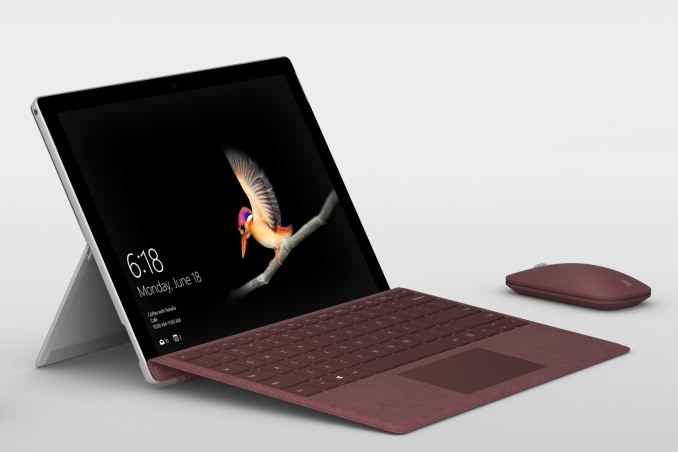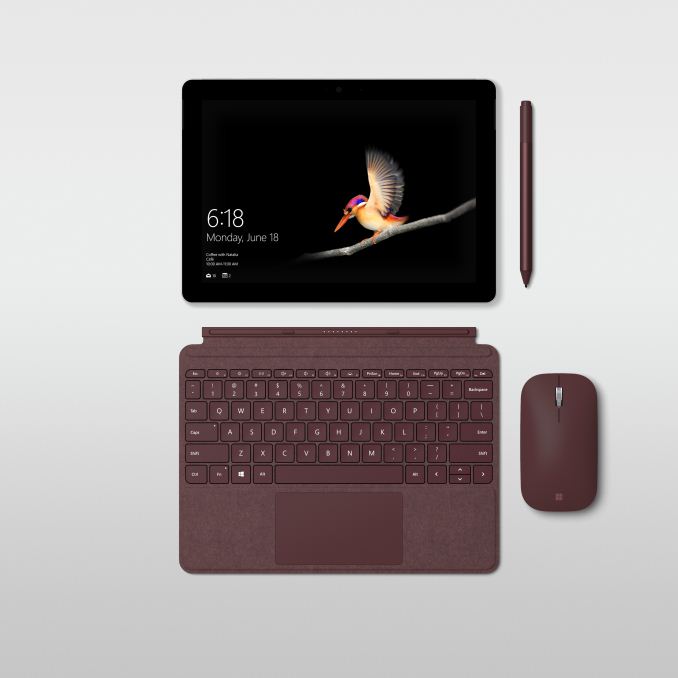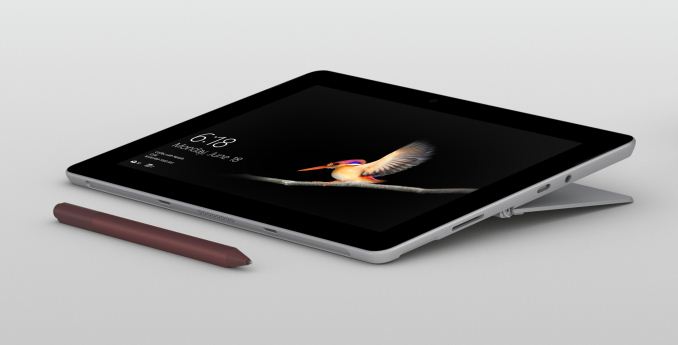Microsoft Announces The Surface Go: Smaller And Less Expensive
by Brett Howse on July 9, 2018 9:15 PM EST- Posted in
- Laptops
- Microsoft
- Surface
- Tablets
- Surface Go

Just over three years since the launch of the surprisingly good Surface 3, Microsoft has finally refreshed this category with a new device, now called the Surface Go. The Surface Pro series has been very successful for the company, and they’ve decided it’s time to offer an entry level Surface again. The Redmond company has been working on trying to win back the education market, so a smaller, lighter, and most importantly, less expensive Surface makes a lot of sense.
The Surface Go is the thinnest and lightest Surface yet at just 8.3 mm, down from the 8.7 mm of the Surface 3, and 8.5 mm on the latest Surface Pro, but it undercuts the other models on weight significantly at 521 grams, or 1.15 lbs. That’s a full 31% lighter than the larger Surface Pro.
The display is also smaller, this time coming in at 10-inches in the now familiar 3:2 aspect ratio Microsoft has focused on, and the taller aspect ratio certainly helps on mobile devices such as this that may be used in portrait. It’s an 1800x1200 PixelSense display, with 10-point multi-touch and Surface Pen support. The screen has a reasonable 216 pixels per inch of density, which is pretty much the same as the Surface 3 back in 2015 which was 213 PPI. That’s not quite as high as the Surface Pro or iPad Pro, but should still be fairly clear.
One of the biggest upgrades over the outgoing Surface 3, which was the first of the value-oriented Surface models to ship with an x86 processor, is the move from the quad-core Atom to an Intel Pentium Gold 4415Y. This is a dual-core Kaby Lake processor with four threads, and a 1.6 GHz base frequency. With a TDP of just 6W, it’s not going to be a powerhouse, but it’ll still offer solid performance for a device of this size. The low TDP also means that it can be fanless, which it is. The CPU is coupled with the Intel HD Graphics 615, which offers 24 Execution Units (EUs), although at just 850 MHz maximum boost. Still, that should offer a good jump over the Atom in the previous model.
The base model comes with just 4 GB of LPDDR3-1866, and 64 GB of eMMC storage, although it will be offered in 8 GB RAM versions with 128 GB and 256 GB NVMe SSDs, which should offer much better performance.
| Microsoft Surface Go | |||||
| Surface Go Specifications | |||||
| CPU | Intel Pentium Gold 4415Y (Kaby Lake-Y) 2 core, 4 thread, 1.6 GHz base frequency |
||||
| GPU | Intel HD 615 24 EUs 850 MHz boost frequency |
||||
| Display | 10-inch PixelSense 1800x1200 3:2 aspect 216 Pixels Per Inch 10-point Multitouch Surface Pen support |
||||
| Dimensions | 245 x 175 x 8.3 mm 9.6 x 6.9 x 0.33 inches |
||||
| RAM | 4 or 8 GB LPDDR3-1866 | ||||
| Storage | 64 GB eMMC 128 / 256 GB NVMe SSD optional |
||||
| Wireless | 802.11ac with Bluetooth 4.1 Qualcomm Snapdragon X16 LTE Optional |
||||
| Battery | Up to 9 hours of video playback 24W Charger |
||||
| Cameras | Windows Hello IR camera 5 MP Front Camera with 1080p video 8 MP Rear Camera with 1080p video |
||||
| Ports | USB Type-C 3.1 Gen 1 with power delivery Surface Connect MicroSD Headset |
||||
| Price | 4GB/64GB $399 8GB/128GB $549 Windows 10 Pro $50 extra |
||||
The Surface 3 was charged with micro USB, but the Surface Go steps up to the 24-Watt magnetic Surface Connect found on the rest of the mobile Surface lineup, and it also includes a USB 3.1 Gen 1 with a Type C connector, and they’ve kept the expandable storage with MicroSD included.
Microsoft has also included an IR camera for Windows Hello login, along with a 5 MP front camera for 1080p video, and an 8 MP rear camera. For those that want to use it on the go (pun intended) there will be an LTE model available too, which makes sense with Microsoft’s push towards Always Connected PCs.
Microsoft is claiming up to 9 hours of battery life which they tested doing video playback on the top end model.
Microsoft is also launching a new Surface Type Cover for the smaller model, featuring the same Alcantara as its larger siblings, or as just black if you prefer that. Microsoft has also found a way to fit their full-friction hinge to the smaller Surface Go, allowing for up to 165° of movement.
The new low-end Surface Go looks like a great replacement for the Surface 3, offering a way into the Surface lineup at a much more affordable price. The move to Kaby Lake will be a major boon to performance as well. Prices start at $399 for the base model, $449 for the same model with Windows 10 Pro, or $549 for 8 GB of RAM and 128 GB SSD. The 256 GB and LTE models will ship later. Pre-orders should be available soon.
Source: Microsoft













111 Comments
View All Comments
North01 - Tuesday, July 10, 2018 - link
"Surface Go can also charge through its USB-C port"https://youtu.be/hBxylZI4zl4?t=4m56s
IntelUser2000 - Monday, July 9, 2018 - link
It seems they opted for the Pentium 4415Y rather than the Pentium Silver N5000 because the HD Graphics 615 is better than the 605 in N5000.They made the tradeoff of using a slower CPU(in both ST and MT by 30% or more) to get better graphics.
Alistair - Monday, July 9, 2018 - link
Sorry, isn't the 4415Y almost twice the speed of the N5000 in single core performance? Core vs Atom.IntelUser2000 - Tuesday, July 10, 2018 - link
Atom-based cores aren't that slow anymore. Goldmont is 30-40% faster than Silvermont, and Goldmont Plus is yet another 30-40% better.2.7GHz Goldmont Plus is quite comparable to 2.2GHz Skylake.
Alistair - Tuesday, July 10, 2018 - link
I'll be looking forward to seeing that. I find it hard to believe honestly :)ZolaIII - Tuesday, July 10, 2018 - link
Well it is faster as new Atoms are 4 instructions per clock OoO compared to the 3 & two one's of earlier generations,but it's not all that much faster as they didn't all that much improved feed. It's still significantly behind Intel's normal cores (would put it to the 60~65% performance metrics) & behind the upcoming ARM competition in the shape oh and A76 (which I would put to 75~85% performance metrics MHz per MHz).serendip - Wednesday, July 11, 2018 - link
Faster on synthetic benchmarks, maybe. In the real world, those Atom cores bring on a Windows lagfest compared to Core cores. I've compared an Atom Surface 3 with a Surface Pro 3 M3 and the latter model is much more responsive. It's probably down to faster single cores and higher GPU performance.The latest Atom cores are decent but they're still way behind Intel's premium cores. I've been using Bay Trail and Cherry Trail Windows tablets for years as my main travel machines, I've gotten used to their slower performance but the average user won't be happy.
Namisecond - Tuesday, July 24, 2018 - link
That explains a lot. Apollo Lake is quite a bit faster clock for clock than Bay Trail. I'd say 30-40% faster and Gemini Lake is another 20-30% faster on top of that. The lag you've experienced was most likely due to eMMC in the Surface 3. I'm currently using an Apollo Lake netbook with a real SSD and it runs quite acceptably well even with 4 GB of ram.LiverpoolFC5903 - Tuesday, July 10, 2018 - link
What? If i am not mistaken, the IPC of the Kaby Lake cores is almost 2 times that of Atom/Apollo Lake at the same process node and frequency. A 1.6 ghz 'Big' core will still be faster and snappier than a 2.5 GHZ small core.If you have any links to back your statement asserting the performance of a 2.7 GHz goldmont core is in the ballpark of a 2.2 GHz Skylake, please share.
grahad - Tuesday, July 10, 2018 - link
I want whatever he's smoking, cause it's good stuff.PassMark: https://www.cpubenchmark.net/compare/Intel-Pentium...